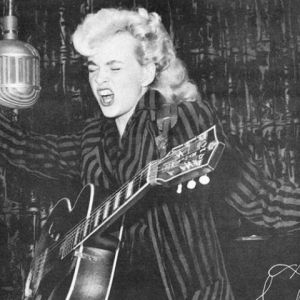From Open Culture: “For sixty years, conventional wisdom has told us that women generally did not perform rock and roll during the 1950s,” writes Leah Branstetter, Ph.D. candidate in musicology at Case Western Reserve University. Like so many cultural forms into which we are initiated, through education, personal interest, and general osmosis, this popular form of Western music—now a genre with seventy years under its belt—has functioned as an almost ideal example of the great man theory of history.
It can seem like settled fact that Chuck Berry, Elvis Presley, Jerry Lee Lewis, Little Richard, Buddy Holly, and their celebrated male contemporaries invented the music; and that women played passive roles as fans, studio audience members, groupies, personifications of cars and guitars….
The recognition of rare exceptions, like Sister Rosetta Tharpe, does not challenge the rule. But Branstetter’s Women in Rock and Roll’s First Wave project almost single-handedly does.
The reality is, however, that hundreds—or maybe thousands—of women and girls performed and recorded rock and roll in its early years. And many more participated in other ways: writing songs, owning or working for record labels, working as session or touring musicians,designing stage wear, dancing, or managing talent…. [W]omen’s careers didn’t always resemble those of their more famous male counterparts. Some female performers were well known and performed nationally as stars, while others had more influence regionally or only in one tiny club. Some made the pop charts, but even more had impact through live performance. Some women exhibited the kind of wild onstage behavior that had come to be expected from figures Jerry Lee Lewis or Little Richard—but that wasn’t the only way to be rebellious, and others found their own methods of being revolutionary.
Branstetter’s project, a digital dissertation, covers dozens of musicians from the period, just a fraction of the names she has uncovered in her research. Some of the women profiled were never particularly well-known. Many more were accomplished stars before the 60’s girl group phenomenon, and continued performing into the 21st century.
Read more at Open Culture.


